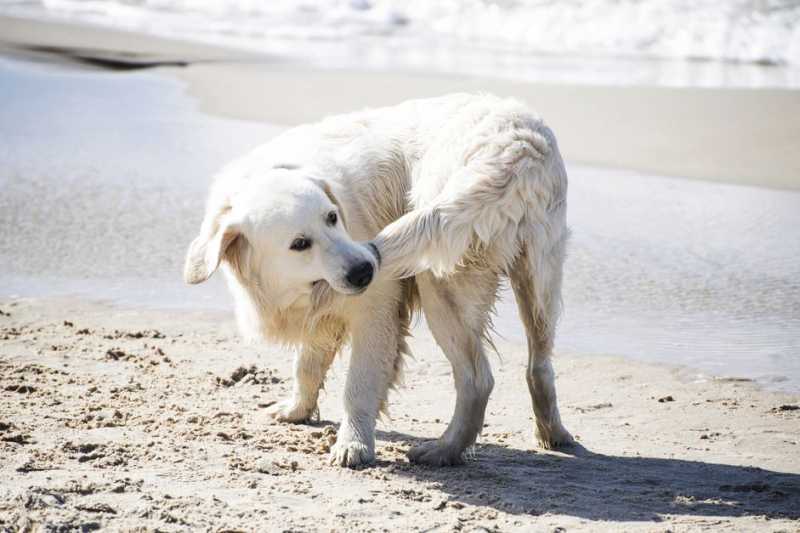Tail chasing may seem like a strange quirk that your dog has, but most behaviorists believe it is actually a normal and essential component of play activity. Excessive or compulsive tail chasing, though, is not normal dog behavior and may require intervention.
Why Do Dogs Chase Their Tails?
Tail chasing is an activity that begins in puppyhood. Puppies may chase their tails as a way to explore their own bodies and explore the world around them. Tail chasing may continue into adulthood as a way to stave off boredom.
Although tail chasing is considered to be a normal behavior, it may be considered abnormal if your dog chases their tail excessively or it is difficult for you to redirect them from their tail chasing. There are medical reasons for tail chasing, especially if your dog is also chewing, biting, and licking their tail and rear. Dogs can chase their tails because they are painful or itchy from things like fleas, allergies, irritation from diarrhea or intestinal parasites, and even spinal trauma.
A dog may also excessively tail chase due to compulsive behavior disorder. Compulsive behavior disorder in dogs is a behavioral disorder oftentimes equated to Obsessive Compulsive Disorder in humans because of their similarities. As with all behavioral disorders, medical causes of tail chasing should be ruled out before a diagnosis of compulsive behavior disorder is settled upon.
If your dog’s tail chasing is a frequent, daily, or multiple times a day activity, it may be a manifestation of compulsive behavior disorder. Dogs that excessively tail chase, especially if it is because of compulsive behavior disorder, may injure themselves while chasing their tail. This can include creating open wounds on their tail, injuries from running into things while spinning, and even paw pad injuries from the constant chasing.
How to Stop Your Dog From Chasing Their Tail
Since most manifestations of tail chasing are normal behaviors, they aren’t necessarily ‘true’ nuisance behaviors. If you wanted to stop your dog from chasing their tail so much, there are things that you can try. Ensuring that your dog has a variety of mentally stimulating, enriching, or interactive toys, such as puzzle feeders or puzzle toys, can help your dog from feeling bored, which may lead to tail chasing. You can also try to redirect them when they start chasing their tail by tossing them a toy to play with instead.
If your dog chases their tail multiple times a day, despite trying the above measures, they may need to be checked over by your vet. Your vet will thoroughly examine your dog. This may include a neurological exam to check for any spinal trauma or injury that may be causing pain or irritation. Skin scrapes and samples taken with tape will be looked at microscopically to check for any bacterial or fungal infections as well as any parasites. Your vet may also request that you bring a fresh stool sample to the appointment so that they can check for any intestinal parasites.
If a medical reason is found for your dog’s excessive tail chasing, treatment will depend on the cause. Medications can be prescribed to treat infections and parasites. Spinal injuries may require further, more specialized testing to determine how bad the trauma is.
If these tests and exams yield no definitive reason for your dog’s excessive tail chasing, your vet may settle on a diagnosis of compulsive behavior disorder. Compulsive behavior disorder is actually a disorder that can manifest with various obsessive and compulsive behaviors. Tail chasing is one, but dogs with compulsive behavior disorder may also exhibit other repetitive behaviors such as trancing; fly biting; and excessive licking of either of themselves, their owners, objects such as blankets, and even the air.
Certain breeds may be predisposed to compulsive behavior disorder, bull terriers and German Shepherd dogs being the most prone. They even have the earliest onset of the disorder . A dog that tail chases because of compulsive behavior disorder may be more likely to have an episode in stressful situations. Tail chasing episodes may also become more frequent and more difficult to distract your dog from as their compulsive behavior disorder progresses.
Compulsive behavior disorder may be treated with SSRIs such as fluoxetine as well as sedatives, such as acepromazine or trazodone. At home, you can try to limit your dog’s stress with a regular daily routine. This includes regular walks and feeding times at the same time each day.
Tail chasing usually is a normal behavior seen in dogs, but if you’re concerned about how often your dog chases their tail, speak to your veterinarian.












